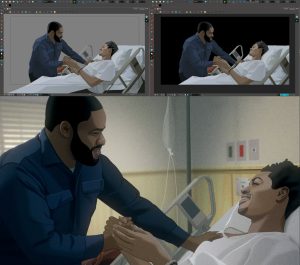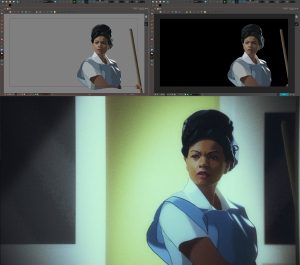

I Was Born This Way is a documentary which recently debuted at the Tribeca Film Festival. The film depicts the life of Archbishop Carl Bean — an AIDs activist, pop singer, and prelate of the Unity Fellowship Church Movement. Produced by Wellington Love, I Was Born This Way was made in collaboration with directors Sam Pollard and Daniel Junge, with animation from Mitch Pond, Scott Hassell and Dave Bardin.
The film uses a mixture of archival footage, interviews, and beautifully-crafted animated sequences. Mitch Pond’s contributions in I Was Born This Way involve rotoscoping in a hybridized style that sits somewhere between live-action and animation, resulting in realistic but also unmistakably dream-like tone. Rotoscoping is a technique that is sometimes misunderstood. Less of a shortcut to making animation, it can be more challenging to create than first meets the eye.
Mitch Pond honed his craft in the rotoscope department of Adult Swim's Dream Corp LLC as well as animating surreal music videos for artists like Fruit&Sun. Mitch spoke with us about his work on I Was Born This Way, his approach to rotoscope animation, and the pipeline he developed to achieve his unique style using Toon Boom Harmony.
Mitch: I started teaching myself animation in 2013, and I began by making music videos for local bands in Denver, where I’m from. I moved to Los Angeles in 2016, and one day at my office job I received a direct message from one of the producers of the Adult Swim series Dream Corp LLC asking if I was available to do some freelance work.
I immediately put in my two weeks notice, and worked in the rotoscope department on Dream Corp LLC during seasons 2 and 3. When the pandemic began I returned to doing music video work for musicians in Los Angeles. In late 2020 I was contacted by Daniel Junge, one of the directors of “I Was Born this Way”, who asked me to work on the film.
So I hired two of my friends from Dream Corp LLC to assist, and we worked on and off for the next four years until we finished in May. The film premiered at the Tribeca Film Festival on June 5th.

Mitch: The film is about Archbishop Carl Bean, and the most common response I’ve seen is that people are shocked that they weren’t already familiar with him. Carl Bean’s story is incredible. He recorded the single I Was Born This Way for Motown, considered the first gay anthem in pop music history, and later founded both the Minority AIDS Project and the Unity Fellowship Church in Los Angeles.
It’s an inspiring story about a very courageous man, and the best part of the film being released is knowing more people are going to hear it.
Mitch: One of my favorite moments was when I started getting the first rounds of shots back from my collaborators, Scott Hassell and Dave Bardin. Rotoscope is a bit of a niche technique, and the kind of interpolated rotoscope animation we were doing on Dream Corp LLC is even more niche. Prior to developing the Toon Boom Harmony workflow we used on the film, most if not all of the software that I knew of for producing this kind of rotoscope animation was proprietary.
This was my first experience managing a team, and though Scott and Dave are both phenomenal artists, I was anxious that the workflow I’d developed in Harmony would be too idiosyncratic for production on this scale. There were a lot of workarounds and tools being used in ways they weren’t necessarily intended to be used. When we got going and started delivering shots that looked great and were on schedule, that was a great feeling.

Mitch: Rotoscope is a technique almost as old as animation itself. It was developed at Fleischer Studios in 1915. The technique involves using live-action footage as a guide for the animation process, allowing for a sense of realism in design and movement that’s very difficult to achieve with traditional animation.
There are incredible examples of rotoscope throughout animation history, including notably in the original Snow White and the Seven Dwarves. My first exposure to the technique was in the work of Ralph Bakshi, who used the technique extensively and in an innovative way.
Mitch: I have noticed a significant increase in the use of animation as a story-telling tool in documentaries, and it’s quite effective. The core of I Was Born This Way is a series of interviews conducted over a few days with Carl Bean, and one of the hurdles the producers of the film had to deal with was a relative lack of archival footage to help tell the story. Some of the reenactments in the film deal with heavy subject matter, and so traditional, stylized character animation may have felt inappropriate.
I think Daniel Junge was looking for an alternative to the typical style of live-action re-enactment, and rotoscope was a great option. It meant there was not a need for elaborate sets, only great performances from the live-action actors. My team completed the character rotoscope, and the background elements were created by the team at Milkhaus. It also meant that the animated re-enactments could have a cinematic style with naturalistic camera movement, and we could capture the subtle emotions of the performers.
Mitch: I don’t see how anyone could be in any way involved with the arts and not be in awe of the creative legacy of Black and queer artists. That so much of the work that makes up this legacy was created in a culture that may have valued the work but so often did not value the human beings who created it is a tragedy. Carl Bean wanted to be a singer but he also wanted to be a change-maker, and he did both. He dedicated his life both in and out of music to his belief that love is for everyone, which shouldn’t be a brace thing to say but which absolutely is. I think all artists should aspire to that kind of courage.
It’s always a challenge to animate real people, particularly when their likeness is readily recognizable. Because Carl Bean is not as well known to the public as he should be, and because actors were used to portray Carl Bean throughout different times in his life, in this case our focus was mostly on capturing the emotional subtleties in the performances necessary to elevate the story.

Mitch: I mentioned earlier that the workflow that was developed for this film is idiosyncratic and involves lots improvised solutions. The foundation of our approach is the morph tool. It interpolates the points between keyframes on hand-drawn vector lines and shapes to avoid making hundreds of nearly-identical frames. From what I’ve seen, it is used mostly for assisting with things like slow moving clouds of smoke or other subtle FX work.
When I first became aware of this feature, I thought I might be able to use it as the basis for an interpolated rotoscope workflow similar to what we did on Dream Corp LLC, and which can also be seen in some of Richard Linklater’s films like Waking Life and A Scanner Darkly. I quickly realized that there wasn’t anyone out there using the tool this way, and so whenever I ran into a problem with the workflow I had to figure out the solution on my own because nobody had run into it before.
While I’m sure there are more elegant solutions to some of these problems, the workflow I developed with the help and feedback of my collaborators, Scott and Dave, enabled a team of three to hand-animate over 150 character animation shots at 24 frames per second with a high level of detail in what would have been less than two years had the production schedule been continuous.
Mitch: The biggest challenge we faced is also the reason I am most proud of our work on this film. Daniel Junge, along with his co-director Sam Pollard and producer Wellington Love, fought a steeply up-hill battle to get the film made. They were constantly fund-raising for the film, and we had several stretches where we had to stop down for a few months so they could find more budget to keep the production going.
As a team, the three of us were very efficient compared to what’s normal in terms of time per finished minute of animation. But inexpensive relative to the industry standard does not mean inexpensive. The producing team did a lot of hard work to raise the money for this film, and in turn we did a lot of hard work to make that money count as much as possible.
Mitch: I Was Born This Way is currently screening at several festivals this summer. It premiered at Tribeca and had a screening at the DC/Dox Fest in Washington DC. The next screening is at the Frameline International LGBTQ+ Film Festival in San Francisco on June 19th. Following that, there is a screening at the Sheffield DocFest in the UK on June 22nd. More screenings will be announced soon, so keep an eye out.
The post Mitch Pond on stunning rotoscope animation in I Was Born This Way appeared first on Toon Boom.